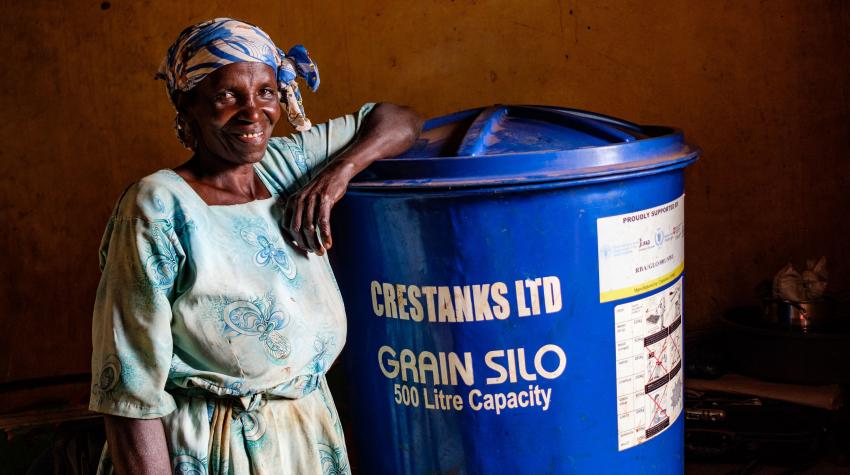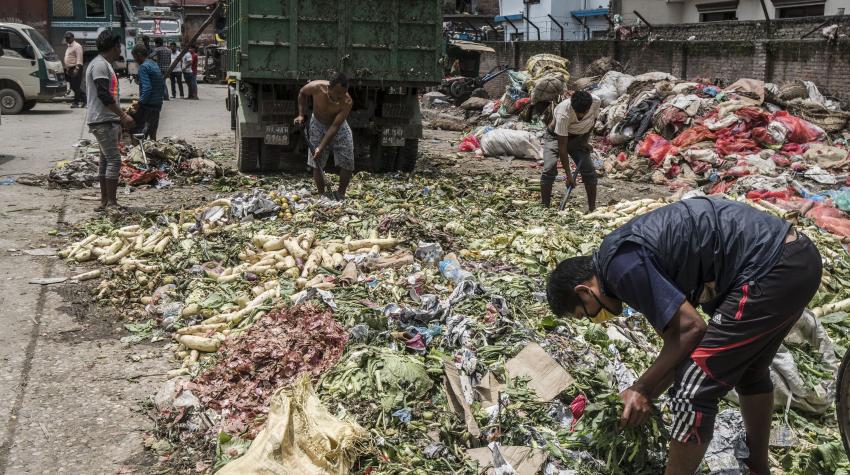Reducing food loss and waste represents a “triple-win” opportunity—for the climate, for food security and for the sustainability of our food systems. It must be a priority in these times of rising food insecurity, malnutrition and hunger across the globe.
For many of us on the planet today, food is something we take for granted. But for the staggering millions who are hungry or food insecure, food is not a guarantee.
These are tumultuous times. Two years of the COVID-19 pandemic, climate change and the war in Ukraine have disrupted our global food systems, pushing millions into food insecurity. According to the 2022 The State of Food Security and Nutrition in the World report (SOFI), the number of people affected by hunger globally rose to as many as 828 million in 2021, an increase of about 46 million since 2020 and 150 million since 2019. Overall, an estimated 3.1 billion people worldwide do not have access to a healthy diet.
Meanwhile, around 14 per cent of the world's food, valued at $400 billion per year, continues to be lost after it is harvested and before it reaches retail, while a further 17 per cent—approximately 931 million tons of food—ends up being wasted in retail and by consumers. Much of this food waste takes place in households.
Food loss and waste (FLW) implies unnecessary pressure on the environment and the natural resources used to produce it in the first place. It essentially means that land and water resources have been wasted, pollution created and greenhouse gases (GHGs) emitted to no purpose.
Food loss and waste contribute to climate change
GHGs are generated at every step in the food supply system—from production through handling, transportation, storage and distribution—regardless of whether the food produced is consumed, discarded or wasted. Food processing and packaging, together with transport and food waste, are thrusting the food supply chain to the top of the list of GHG emitters globally. The shipping of fruits and vegetables, for example, more than doubles their production-related emissions due to the necessity of transporting large volumes in temperature-controlled environments.
Reducing FLW is enshrined in Sustainable Development Goal (SDG) 12 on Responsible Consumption and Production, specifically in target 12.3.
In 2019, pre- and post-production processes were significant emitters of methane—accounting for 49 million tons per year—a potent GHG mostly generated from the decay of solid food waste in landfills and open dumps.
FLW accounts for 8 to 10 per cent of global GHGs, contributing to an unstable climate and extreme weather events such as droughts and flooding. These changes negatively impact crop yields, cause supply chain disruptions, and threaten food security and nutrition.
Climate shocks contribute to food loss and waste
In the upstream segments of the food supply system, where losses predominate, there is a growing body of evidence to suggest that GHGs contribute to a reduction in total crop yields and could potentially impact the nutrient levels of a number of food crops.
GHGs contribute to extreme weather events that are disruptive to supply chain resilience. Changes in agroecological conditions brought about by these extreme weather events are giving rise to new pests and diseases that reduce crop yields, contribute to field-level losses and increase infestations in stored crops, with potentially negative impacts on human health. These impacts are particularly devastating for smallholder farmers and the poor in low-income countries.
Further downstream, food manufacture and distribution can also be affected by climate change in ways that often go unnoticed. The inability of ships to access ports owing to weather events often results in FLW.
Stemming the food loss and waste problem
Prioritizing the reduction of FLW is critical for the successful transformation of agrifood systems to make them more efficient, inclusive, resilient and sustainable, diminishing their impact on the planet and ensuring food security and nutrition. This reduction would also address climate change, which, in turn, would decrease climate-related shocks to the food supply system.

Reducing FLW is enshrined in Sustainable Development Goal (SDG) 12 on Responsible Consumption and Production, and specifically in target 12.3, which seeks, by 2030, to halve per capita global food waste at the retail and consumer levels and reduce food losses along production and supply chains, including post-harvest losses.
The Food and Agriculture Organization of the United Nations (FAO) in 2019 reported on the Food Loss Index Indicator, while the United Nations Environment Programme (UNEP) in 2021, reported on the Food Waste Index indicator. Both agencies are currently working on the development of a methodology to combine both indicators into an SDG indicator for reporting on target 12.3.
Reducing FLW is a programme priority area in the FAO Strategic Framework 2022–31, in support of the 2030 Agenda for Sustainable Development. FAO, through its current work, is supporting countries in their efforts to identify and overcome challenges to addressing FLW reduction at scale by adopting a holistic systems approach to fill knowledge and capacity gaps; strengthen policy, regulatory and institutional frameworks; and to incentivize and stimulate action by food supply chain actors “from farm to fork” in all agricultural sectors.
Circular approaches are promoted to ensure that resources invested in food production are secured and optimized in a sustainable manner. Priority is accorded to actions that prevent FLW from occurring in the first place, followed by rescue, recovery and redistribution of surplus or unsold/unmarketable food; recycling and upcycling through circular strategies; and proper disposal of remaining material. This work places particular emphasis on the early stages of value chains, where higher inclusion, poverty reduction, food security and nutrition gains can be expected.
The third observance of the International Day of Awareness of Food Loss and Waste reminds us that we all have an important role to play in reducing FLW.
Results of a recently concluded project funded by the Swiss Development Agency and implemented in Burkina Faso, the Democratic Republic of Congo and Uganda by the United Nations Rome-based Agencies (RBAs), highlight the critical need for a paradigm shift in current research and development programmes aimed at food loss reduction. An analysis of project outcomes highlights the importance of collecting context-specific data on food losses, thus implying that no one size fits all—that solutions to reduce food loss must be comprehensive, science-based and context-specific.
Ahead of the upcoming 2022 United Nations Climate Change Conference (COP 27), members of the Food is Never Waste Coalition—launched at the Food Systems Pre-Summit to take forward the FLW agenda following the Food Systems Summit 2021—developed a Global Food Loss and Waste Pledge designed for governments, businesses and institutions to make voluntary commitments to reduce FLW in order to accelerate progress towards meeting SDG target 12.3.
This third observance of the International Day of Awareness of Food Loss and Waste on 29 September 2022 reminds us that we all have an important role to play in reducing FLW—governments, private actors in the food supply chain, researchers and academia, and consumers. Each of our contributions will go a long way to improving planetary health and nutrition for our present and future generations.
For further information and data on FLW, please see the FAO Technical Platform on the Measurement and Reduction of Food Loss and Waste.
The UN Chronicle is not an official record. It is privileged to host senior United Nations officials as well as distinguished contributors from outside the United Nations system whose views are not necessarily those of the United Nations. Similarly, the boundaries and names shown, and the designations used, in maps or articles do not necessarily imply endorsement or acceptance by the United Nations.




